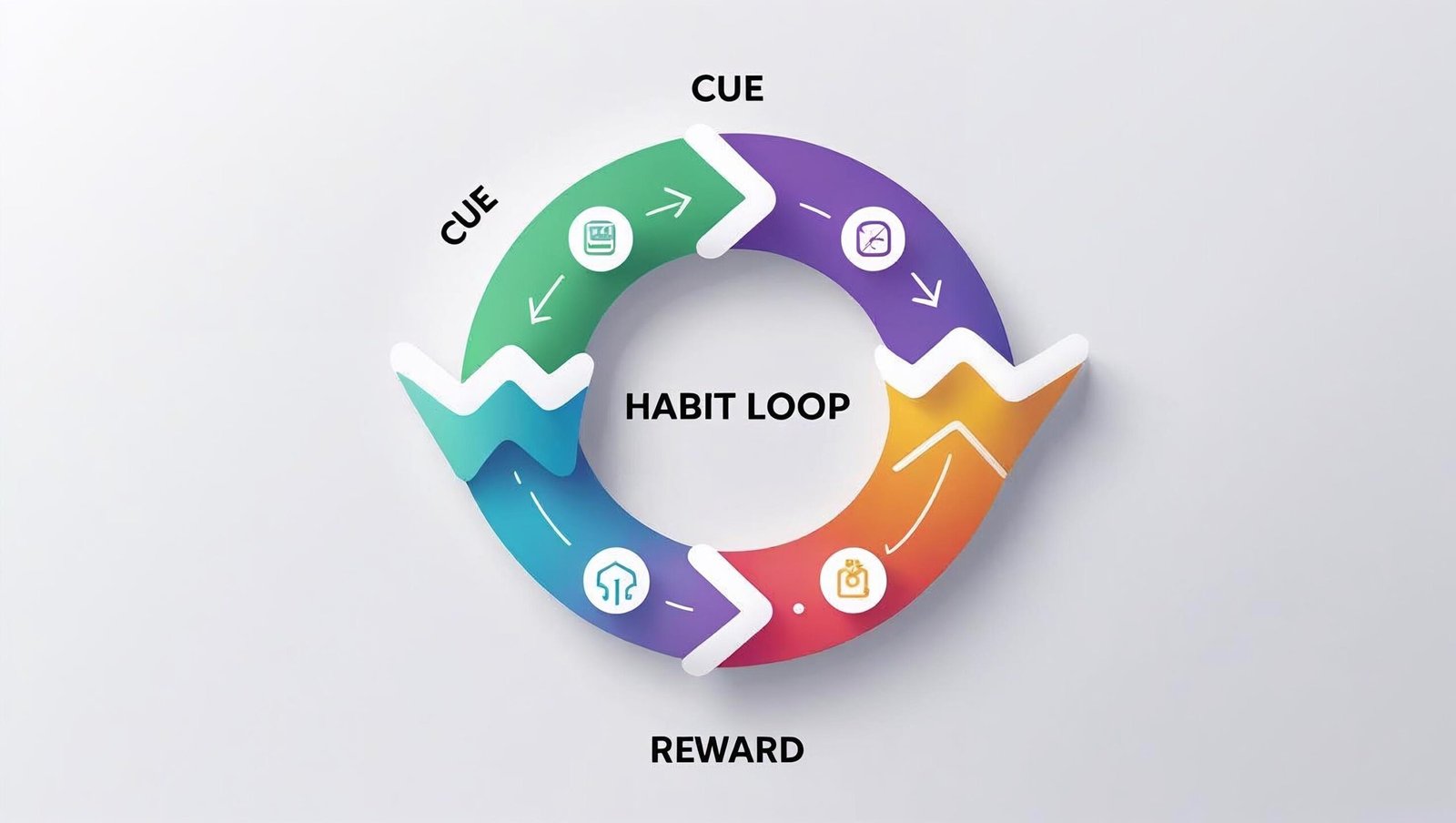Introduction
In an era dominated by routines, distractions, and relentless multitasking, the importance of cultivating productive habits cannot be overstated. Charles Duhigg’s bestselling book, The Power of Habit, offers a compelling exploration into how habits govern our lives—and how we can change them. This in-depth review of The Power of Habit explores the book’s key concepts, psychological insights, case studies, and practical applications.
Duhigg, a Pulitzer Prize-winning journalist, does more than just explain the science of habits; he dives deep into why we do what we do, and how seemingly minor changes in behavior can yield profound transformations in personal life, work, and society. This review is structured around nine transformative lessons that encapsulate the essence of the book while presenting actionable takeaways.
Moreover, Duhigg’s insights go far beyond individual habit change. He uncovers the role habits play in businesses, organizations, and social movements, offering a broad and empowering view of how mastering habits can lead to personal breakthroughs and societal progress. His message is powerful: habits are not destiny. With awareness and intention, we can reshape them.
From Olympic swimmers to corporate executives and recovering addicts, Duhigg’s narratives underline the universality of habit-driven behavior and the potential to overcome destructive routines through conscious redesign. The Power of Habit stands as a practical guide for anyone who wishes to evolve—not by willpower alone but by systemically transforming the invisible architecture of behavior.
Let us now explore the core insights presented in The Power of Habit through the nine lessons that can be life-changing if applied diligently.

Lesson 1: The Habit Loop – Cue, Routine, Reward
One of the most pivotal insights in The Power of Habit is the “habit loop.” This neurological loop consists of three core components:
- Cue: The trigger that initiates the behavior
- Routine: The behavior itself
- Reward: The benefit you gain
Duhigg illustrates how understanding and manipulating the loop can enable us to replace bad habits with positive ones. For instance, a smoker might recognize the cue (stress), substitute a healthier routine (deep breathing or a walk), and still receive the reward (relief or satisfaction).
Real-Life Application: Identify one bad habit in your daily routine. Break down its habit loop and intentionally replace the routine while maintaining the same cue and reward.
Lesson 2: Keystone Habits – The Habits That Matter Most
Duhigg introduces the concept of keystone habits—those that, when changed, have a ripple effect across other areas of life. These habits lead to small wins and create a structure for other positive behaviors to flourish.
Example: Regular exercise not only improves health but also encourages better eating, increased productivity, and reduced stress.
Real-Life Application: Identify one keystone habit in your life (e.g., sleep, journaling, exercise) and focus on improving it. Observe how other areas naturally follow suit.
Lesson 3: The Golden Rule of Habit Change
To change a habit, keep the old cue and reward, but change the routine. This simple rule is the foundation of successful habit replacement.
Example: Replacing the habit of eating junk food when stressed with drinking a cup of herbal tea while keeping the same cue (stress) and reward (comfort).
Real-Life Application: Choose one bad habit, identify the cue and reward, and experiment with a new routine that delivers the same emotional payoff.
Lesson 4: How Belief Powers Change
Change becomes sustainable when it’s anchored in belief—particularly belief in oneself or a group.
Example: Many people successfully break bad habits through support groups like Alcoholics Anonymous because of the collective belief system.
Real-Life Application: Cultivate a personal belief system or join a supportive community that reinforces the possibility of change.
Lesson 5: Willpower Is the Most Important Habit
Willpower, Duhigg argues, functions like a muscle—it gets stronger with use but can also become fatigued. Strengthening it is a keystone for habit transformation.
Example: Teaching children delayed gratification (e.g., marshmallow test) predicts future academic and social success.
Real-Life Application: Practice small acts of self-control daily (e.g., choosing water over soda) to gradually build willpower.

Lesson 6: The Role of Cravings
Habits emerge because the brain begins to crave the reward. Understanding and redirecting these cravings is key to changing behavior.
Example: Duhigg describes how toothpaste became a habit not due to hygiene, but due to the craving for the tingling sensation it provided.
Real-Life Application: Recognize the craving behind a habit and find healthier ways to satisfy it without losing the psychological reward.
Lesson 7: Organizational Habits
Just as individuals have habits, so do organizations. Companies can transform their culture by identifying and altering organizational routines.
Example: Alcoa’s focus on safety as a keystone habit led to improved overall performance.
Real-Life Application: If you’re part of a team or business, assess one ingrained routine that might be reshaped for better efficiency or morale.
Lesson 8: The Power of Crisis
Crises provide the best opportunity for deep change because they disrupt established patterns. Duhigg explains how organizations and people often change their habits when they’re forced to.
Example: After a fire in a London Underground station, management restructured the system, using the crisis to rebuild habits from the ground up.
Real-Life Application: Use personal or professional crises as leverage points to implement the changes you’ve long been putting off.
Lesson 9: Habits and Social Movements
Social habits, when formed around strong leadership and shared belief, can drive large-scale change. Movements like the civil rights movement thrived on social habits fueled by networks and identity.
Example: Rosa Parks’ arrest sparked change because of pre-existing social ties and collective identity.
Real-Life Application: Join or create networks that support shared goals. Social accountability can turn personal change into a movement.
Expanded Reflections and Advanced Applications
While Duhigg’s lessons offer immense value, their application deepens when integrated into a broader self-development plan. Habit change is not a one-time effort—it’s an ongoing process that requires patience, consistency, and adaptability. The Power of Habit emphasizes this principle throughout its pages.

Habits in the Digital Age
With digital devices dominating our time, new habits—both good and bad—form rapidly. Scrolling social media, constant notifications, and multitasking are all rooted in powerful habit loops.
Solution: Use apps that track screen time, set scheduled digital detox periods, and design positive routines like reading, journaling, or mindful walks to replace compulsive digital use. The Power of Habit provides a roadmap for this shift.
Building Community Through Shared Habits
Shared habits, like weekly team check-ins or family dinners, create cohesion and trust. Organizations that nurture healthy shared habits tend to have stronger cultures and better performance. The Power of Habit extends its insight to these dynamics.
Habit Stacking for Productivity
Habit stacking, popularized by James Clear, involves linking new habits to existing ones. For example, after brushing your teeth, you might stretch for 5 minutes.
Tip: Identify a stable anchor habit and attach your new desired habit to it. This idea builds upon the core principles taught in The Power of Habit.
Environmental Design and Habit Triggers
Changing your environment can drastically affect your habits. If you want to read more, place books where you can easily reach them. If you want to stop eating junk food, keep it out of your home.
The Power of Small Wins
Tracking small wins and rewarding yourself builds motivation. Small accomplishments fuel larger changes and reinforce new habits. Duhigg explores this concept thoroughly in The Power of Habit.
Neuroscience Behind Habit Formation
Repeated behavior strengthens neural pathways. With time, actions become automatic. This brain plasticity explains both the difficulty and the potential in changing habits, a concept made central in The Power of Habit.
Reflection and Journaling
Keeping a habit journal helps in identifying triggers, patterns, and progress. Reflection makes habit change more conscious and deliberate. As The Power of Habit explains, awareness is the first step.

Real-Life Success Stories Inspired by The Power of Habit
The impact of The Power of Habit stretches far beyond its pages. Since its publication, readers around the world—from CEOs to students—have embraced Duhigg’s principles to overhaul their habits and improve their lives. These success stories provide powerful validation for the book’s teachings and underscore its practical applicability.
1. A Tech Executive Who Transformed Team Culture
Consider the story of a senior product manager at a tech firm in Bengaluru who used The Power of Habit to rebuild team morale and performance. By identifying toxic meeting routines and replacing them with transparent communication norms, she improved the team’s productivity by 40% within three quarters.
The secret? She applied the keystone habit principle by introducing structured daily stand-ups and reward mechanisms like public appreciation for completed milestones. These new routines cascaded into improved project ownership and stronger collaboration.
Key Takeaway: Organizational habits can be restructured through leadership, intention, and consistency.
2. A Fitness Coach’s Habit Loop Makeover
Rahul Verma, a fitness coach based in Hyderabad, openly credits The Power of Habit for helping his clients sustain long-term fitness routines. One of his breakthrough strategies was identifying the reward his clients were truly craving—not just physical transformation, but the sense of confidence that came after a workout.
He used this understanding to craft customized cues like daily reminders, routines like group training, and rewards such as milestone celebrations and progress tracking. Over 60% of his clients stayed consistent for over a year—far above the industry norm.
Key Takeaway: When you tailor habit loops to emotional rewards, long-term change becomes achievable.
3. A Student’s Battle Against Procrastination
An MBA student from Delhi University struggled with chronic procrastination. After reading The Power of Habit, she began analyzing her behavior. Her cue was boredom or anxiety, the routine was binge-watching, and the reward was mental escape.
Using Duhigg’s formula, she re-engineered her loop: keeping the cue (anxiety), replacing the routine with 20-minute focused reading sessions, and still earning the reward (mental engagement and eventual relaxation). She not only improved her academic performance but also reported lower stress levels.
Key Takeaway: Awareness of triggers and emotional needs can turn a destructive habit into a constructive one.
4. Startup Founder’s Use of Habit Stacking
A startup founder in Pune used habit stacking—introduced in The Power of Habit and later expanded by other authors—to create a powerful morning ritual. He paired his coffee-making routine with goal review, journaling, and a 10-minute mindfulness session. Anchoring new habits to familiar ones helped him maintain consistency even on hectic days.
This stack, over time, became a keystone that boosted clarity, focus, and emotional balance—all critical for high-pressure decision-making.
Key Takeaway: The best way to sustain good habits is to attach them to routines you already perform without fail.
Integrating The Power of Habit in Education
Educators are also increasingly turning to The Power of Habit to improve student engagement and discipline. Some schools in the United States and India have redesigned classroom routines based on habit loop principles.
For example, instead of punishing late submissions, teachers now focus on creating reminders (cues), structured study blocks (routines), and praise or house points (rewards). This shift transforms classroom behavior without resistance.
In extracurricular development too, The Power of Habit has influenced coaching strategies—using habit tracking journals, motivational anchors, and peer support systems.
Key Insight: When students are taught why they behave the way they do, they become more empowered to self-correct.
Extending the Concept to Emotional Habits
Not all habits are physical or behavioral—many are emotional. We can be addicted to anger, pessimism, guilt, or even self-doubt. These emotional patterns often follow similar habit loops.
By identifying emotional cues (e.g., criticism), routines (defensiveness), and rewards (ego preservation), individuals can substitute healthier responses like deep breathing or reframing thoughts.
The Power of Habit subtly nudges readers to take ownership not just of external actions, but also internal emotional habits.
Challenge: This week, monitor one emotional trigger and observe your reaction. Can you change the routine to gain a better emotional reward?

Philosophical Parallels: Ancient Wisdom Meets Modern Science
What’s fascinating about The Power of Habit is how it echoes ancient philosophical teachings. Stoic thinkers like Epictetus and Seneca emphasized self-mastery through repetition and self-awareness—core principles echoed in Duhigg’s narrative.
Similarly, in Eastern philosophies like Buddhism, mindfulness is essentially a tool to become aware of automatic habits and break their spell. Duhigg’s modern take adds neurological backing to these timeless ideas, making them even more compelling in today’s distracted world.
Final Thought: The Power of Habit bridges age-old wisdom and cutting-edge science, offering tools for both spiritual growth and material success.
Conclusion
The Power of Habit is a blueprint for reshaping one’s life, one behavior at a time. Charles Duhigg’s elegant framework empowers readers to take control of their routines and environments to design the lives they desire. It isn’t merely about breaking bad habits—it’s about understanding the hidden architecture of behavior and leveraging it to serve our deepest goals.
From understanding the cue-routine-reward cycle to identifying keystone habits and rewiring cravings, Duhigg hands us the tools for lasting transformation. But more importantly, he gives us hope—that change is possible, no matter how entrenched the behavior.
Whether you are fighting procrastination, striving for consistency, building a healthier lifestyle, or transforming your work culture, The Power of Habit holds the key. Apply its principles with intention, and watch your life evolve—one loop at a time.
Revisit the lessons. Reinforce the loop. Rebuild your life. That’s the power of habit.
Frequently Asked Questions (FAQs)
Q1: What is the central idea of The Power of Habit? A: The book explores how habits work—through a loop of cue, routine, and reward—and how understanding this loop enables us to change habits. The Power of Habit helps decode this mechanism.
Q2: Is The Power of Habit based on scientific research? A: Yes, Duhigg uses extensive scientific research from neuroscience and behavioral psychology to support his theories. The Power of Habit brings these ideas to life through real-world examples.
Q3: Can this book help with quitting bad habits like smoking or procrastination? A: Absolutely. The Power of Habit provides a framework to recognize habit loops and substitute unproductive routines with healthier alternatives.
Q4: What makes this book different from other self-help books? A: Its blend of storytelling, science, and practical strategies make it both engaging and actionable. The Power of Habit stands out through its rigorous approach.
Q5: Who should read The Power of Habit? A: Anyone interested in personal development, behavioral change, leadership, or organizational culture. The Power of Habit is essential reading for all.
Comments from Readers
Shubhanshu Shekhar, shubhanshuinsights.com: “This book was a turning point in my understanding of personal transformation. The concept of keystone habits alone changed how I approach daily routines. The Power of Habit continues to guide my daily life.”
Aditi, Delhi: “The storytelling in The Power of Habit made complex psychology so accessible. I now use habit loops to manage my time better.”
Ramesh K., Bangalore: “Insightful and life-changing! Every professional and student should read The Power of Habit.”
Nikita, Pune: “This book helped me replace my procrastination habit with a more productive morning ritual. I’m grateful for The Power of Habit.”
Rahul, Mumbai: “Duhigg’s work is a blueprint for anyone serious about behavioral change. The Power of Habit is my go-to manual for consistent growth.”